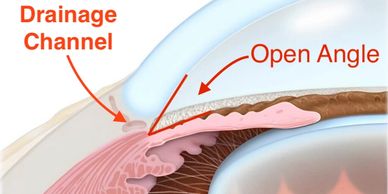Narrow Angles Glaucoma: Understanding the Condition
This is a normal angle
Angle Closure or Closed Angle
This is a normal angle

This is an image of a normal ocular angle. The angle is crucial because it serves as the primary pathway for fluid drainage in the eye. Fluid from the front part of the eye drains into the angle and then through the trabecular meshwork, which acts as a filter. This process is vital in preventing conditions such as angle closure and is an important consideration in glaucoma treatment. The fluid then escapes out of veins near the white of the eye, ensuring proper ocular health, especially for those with narrow angles.
Narrow Angles
Angle Closure or Closed Angle
This is a normal angle

In eyes with smaller diameters or those affected by cataract progression, the angle can become narrower, which may impede fluid flow. This condition can present symptoms or remain asymptomatic. The primary concern with narrow angles is their potential to lead to angle closure, which can occur suddenly. Factors such as medication or high emotional stress can trigger the transition from a narrow angle to a closed angle, complicating glaucoma treatment.
Angle Closure or Closed Angle
Angle Closure or Closed Angle
Angle Closure or Closed Angle

A closed angle, also known as angle closure, is an ocular emergency. The pressure in the eye can rise to dangerous levels, potentially cutting off circulation and leading to permanent vision loss, vomiting, and severe eye pain. In cases of narrow angles, the fluid in the eye cannot escape and continues to build up. If you experience symptoms associated with this condition, seek immediate glaucoma treatment by calling 911 or visiting an ophthalmologist near you.
Treatment: Laser iridotomy
Angle Closure or Closed Angle

For those with critically narrow angles, a small hole in the iris can be created using a laser as part of glaucoma treatment. This procedure allows fluid in the eye to circulate better, thereby decreasing the risk of an angle closure attack. Your eye doctor can review the risks and benefits of this approach.
Ocular imaging: OCT Gonioscopy

At the Inland Glaucoma Center, we provide advanced ocular imaging with OCT, which offers a high-resolution 3D view similar to an MRI of the angle, helping to assess the precise risk of developing angle closure. We also utilize gonioscopy with a mirrored lens, which remains the gold standard in evaluating narrow angles and angle closure.
Symptoms and risk factors
Symptoms of angle closure glaucoma are usually absent but can include transient blurred vision, halos around lights, mild eye pain, headache, and occasionally nausea. Risk factors for this condition include older age, female gender, Asian or Inuit ancestry, farsightedness (hyperopia, which is often associated with narrower angles), and a family history of glaucoma. Effective glaucoma treatment is essential for those at risk.
See a Glaucoma Expert
See a Glaucoma Expert
See a Glaucoma Expert
At Inland Glaucoma Center, we have a UCLA Fellowship-trained Glaucoma Specialist who is Harvard educated and board certified in Ophthalmology. This dedicated MD (Medical Doctor) focuses on glaucoma treatment, particularly in cases involving angle closure and narrow angles. Be sure to check out our blog on angle closure for more information.
Contact Us
Better yet, see us in person!
Hours
Open today | 09:00 am – 05:00 pm |